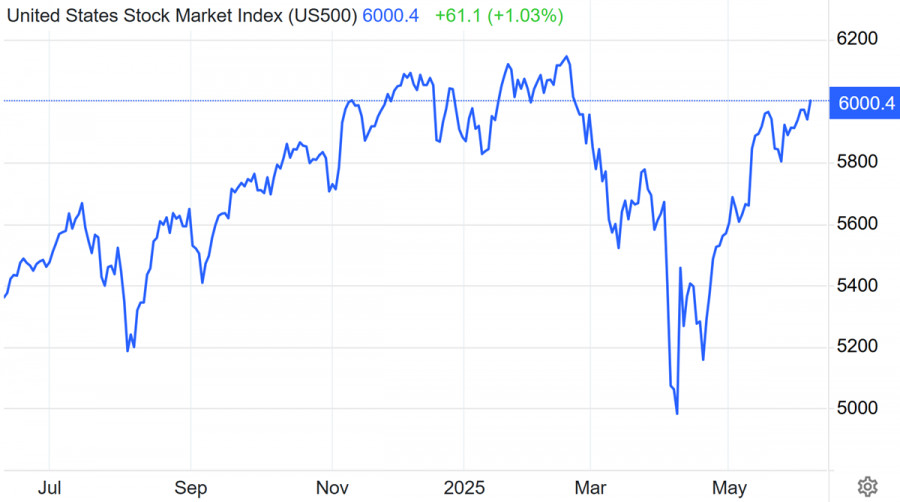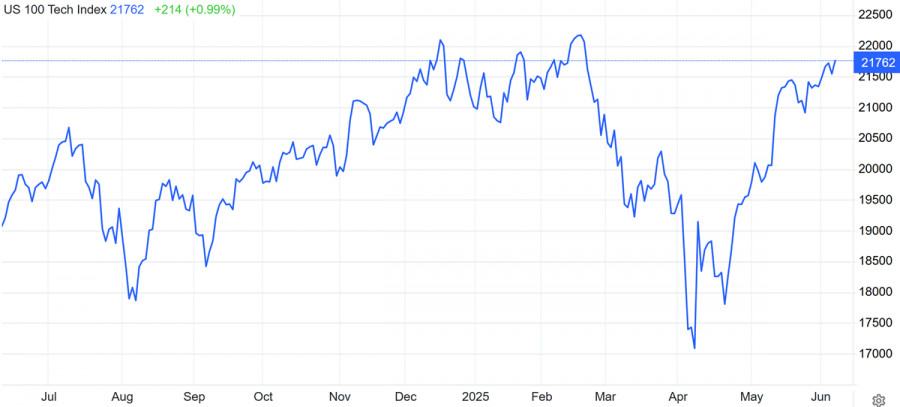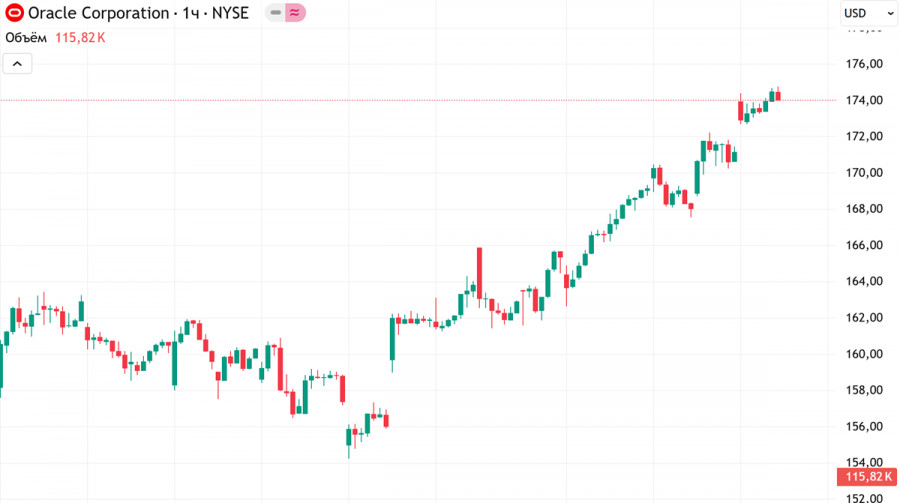The US market is showing resilience and growing amid uncertainty. Optimism is fragile, and each new macroeconomic data release is like a roll of the dice. Further growth in the indices is quite possible amid expectations of dovish rhetoric from the Federal Reserve. However, it is important not to forget that if inflation surprises to the upside, the market could reverse sharply.
The upcoming week is not just a countdown to the Fed meeting, it is a pivotal period that could set the tone for the entire summer in the stock market.
So far, the US equity market ended the past week on a strong note despite a complicated macroeconomic backdrop. The S&P 500 index rose 1.5% over the week. The Nasdaq 100 posted a 2% gain. The Dow Jones, which is more industrial and conservative, added 1.2%.
What is driving this growth?
Perhaps the main paradox of the past week is that markets rose on the back of weak but not disastrous macroeconomic data. The Nonfarm Payrolls report for May came in slightly above expectations—139,000 versus the forecast of 126,000 but still well below the previous reading of 147,000. The unemployment rate held steady at 4.2%, while wages grew faster than expected by 3.9% year-over-year.
Under normal circumstances, this would be a cause for concern. But today, it serves as a reason to hope that the Fed will remain in a wait-and-see mode.
Business activity does not inspire confidence either. The ISM indices in manufacturing and services continue to indicate cooling. The manufacturing sector slipped to 48.5 (compared to a forecast of 49.3), while the services sector fell to 49.9, breaking below the critical 50-point threshold that separates expansion from contraction.
But the markets ignored this. Investors are betting that economic weakening implies future monetary easing.
Additional support came from the European Central Bank. The regulator cut rates by 0.25 percentage points and signaled that the easing cycle may be nearing its end. While this decision has little direct impact on the US, it has reinforced global expectations of cheaper money.
What to watch in coming days
The upcoming week promises to be eventful. Monday will bring inflation and foreign trade data from China, and by Wednesday, the spotlight turns to the US CPI, the key indicator being watched even by those who usually pay no attention to macroeconomic statistics.
Thursday will deliver the PPI report, and Friday will see the release of the University of Michigan's data on consumer sentiment and inflation expectations. These reports effectively serve as a direct lead-in to the Federal Reserve meeting scheduled for June 17–18.
If the CPI comes in hotter than expected, market sentiment could shift dramatically. Markets currently sit at a delicate balance between anticipating dovish policy and fearing a resurgence of inflationary pressure.
If the data is neutral, the path to 6,130 for the S&P 500 remains open. But if the numbers disappoint, profit-taking may begin quickly.
Technical analysis
The S&P 500 index closed the week exactly at a key psychological level. This is a significant threshold, both technically and symbolically. Support lies in the 5,900–5,920 zone, while the nearest resistance is at 6,130.
A breakout above 6,000 on strong volume would signal continued growth. However, the RSI is approaching overbought territory, and in the event of negative macroeconomic data, a pullback to 5,850–5,800 is possible, where solid support from early May is located.
The Nasdaq 100 continues to move within an upward channel. Resistance is at 22,000, and a test of this level could occur as early as next week if CPI data is strong. A confirmed breakout would set the technical target at 22,500. Support is at 21,400, followed by 21,000.
However, RSI is already above 70, indicating an overheated market—especially following the recent 25% rally in Nvidia and other major names.
The triumph of tech sector: who drives market up
While the S&P 500 and Nasdaq 100 push toward new highs, several internal champions are emerging within the tech sector. Three heavyweights stood out last week: Oracle, NVIDIA, and Cisco.
Each demonstrated strong gains, with unique catalysts and risk profiles. Let us examine whether the rally has more room to run or whether it is time to be cautious.
Oracle (+5.1%) – cautious optimism ahead of earnings
Oracle shares continue to rise steadily, gaining 5.1% over the past week and reaching new local highs. This marks the second consecutive wave of growth. The stock is now approaching a key resistance level at $180, a level that has historically triggered reversals.
Meanwhile, the RSI(14) indicates overbought conditions, a notable warning sign. The market is anticipating news and preparing for volatility.
The key upcoming event is the company's quarterly earnings report, scheduled for June 11 after the close of the U.S. session. According to Barron's, analysts expect EPS of $1.64—down from the $1.78 forecast 90 days ago.
This lowered bar may work in Oracle's favor: an upside surprise could be well-received by the market. The consensus price target is $178, but if the report exceeds expectations, a breakout above $180 is entirely plausible.
NVIDIA (+4.9%) — overheated, but still pulls the market
The king of AI and GPUs is back in action. Over the past week, NVIDIA shares rose by 4.9%, hitting a key resistance level at $142. Over the past month, the stock has gained 25%, an impressive result, but one that appears unstable without new catalysts.
Last week's quarterly earnings report exceeded expectations: revenue surged by 69% year-over-year, and margins remained solid. Nevertheless, investors were somewhat cooled by the guidance for the current quarter—it came in less ambitious. While this is not a reason for a sell-off, it also does not provide fuel for further acceleration.
If the stock breaks above $142 on strong volume, the next stop is $150 and this move could happen quickly. The potential upside from the June 6 level is around 6%. However, the overbought condition and the already high base following the strong earnings report create fertile ground for profit-taking at any moment.
Barron's consensus target is $172, implying a further 21% upside. However, the path to that target is likely to be far bumpier than the one seen over the past month.
Cisco (+4.8%) — old giant with new momentum
Cisco has emerged as the quiet giant that suddenly returned to investors' radar. The stock rose by 4.8% and is now close to its yearly high at $66.5. The RSI indicates overbought conditions, but not at a critical level just yet.
If a confident breakout occurs, the target shifts toward $71, supported by Barron's analyst consensus (implying around 8% upside).
In May, Cisco reported fiscal Q3 earnings that beat expectations and issued an optimistic revenue outlook. An additional boost came from strategic deals in the Middle East: the company was tasked with deploying cloud infrastructure in Saudi Arabia and the UAE, with a focus on artificial intelligence.
This is not merely a business expansion. It represents an effort to redefine Cisco's role in the emerging technological landscape.















